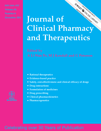Drug interaction between St John’s wort and zolpidem in healthy subjects
Summary
What is known and objective: St John’s wort (SJW, Hypericum perforatum) is one of the most commonly used herbal antidepressants for treatment of mild to moderate depression. SJW enhances CYP3A4 activity and alters the pharmacokinetics of CYP3A4 substrates. This study investigated the effect of SJW on the pharmacokinetics of zolpidem in healthy subjects.
Methods: A controlled, open-label, non-randomized, fixed-dose schedule design was used. Fourteen healthy male subjects received a single 10 mg oral dose of zolpidem followed by SJW administration (300 mg orally, three times a day) for 14 days; the last dose of SJW was coadministered with a single dose of zolpidem. Blood samples were obtained over a 24-h period after zolpidem administration. Pharmacokinetic data for zolpidem alone and in combination with SJW were analysed by high-performance liquid chromatography.
Results: After repeated administration of SJW, the mean values of AUC and Cmax for zolpidem significantly decreased (380·3 ± 181·4 vs. 265·4 ± 134·2 ng h/mL, P = 0·001; 83·1 ± 30·1 vs. 55·1 ± 24·8 ng/mL, P = 0·000 respectively) and the mean value of CL/F for zolpidem significantly increased (38·4 ± 31·5 vs. 56·9 ± 57·2 mL/min, P = 0·040). However, in three subjects, the AUC showed a small increase after SJW treatment.
What is new and conclusion: The effect of SJW on the pharmacokinetics of zolpidem has not previously been reported. Repeated administration of SJW decreases the plasma concentration of zolpidem, probably by enhancing CYP3A4 activity. Given the wide inter-subject variability observed, for personalized medicine, advice on the use of the combination should be individualized, based on the circumstances of the patient.




